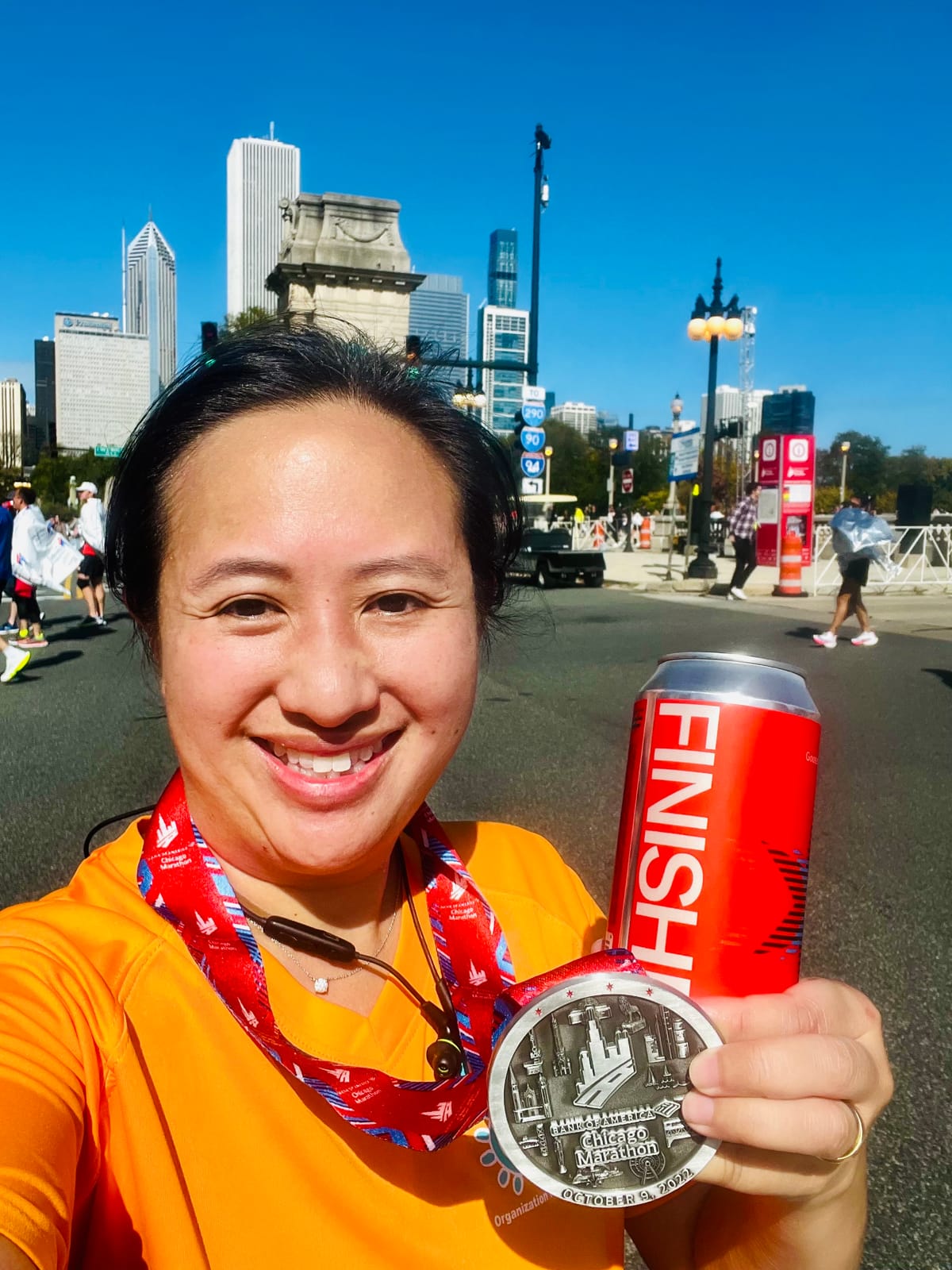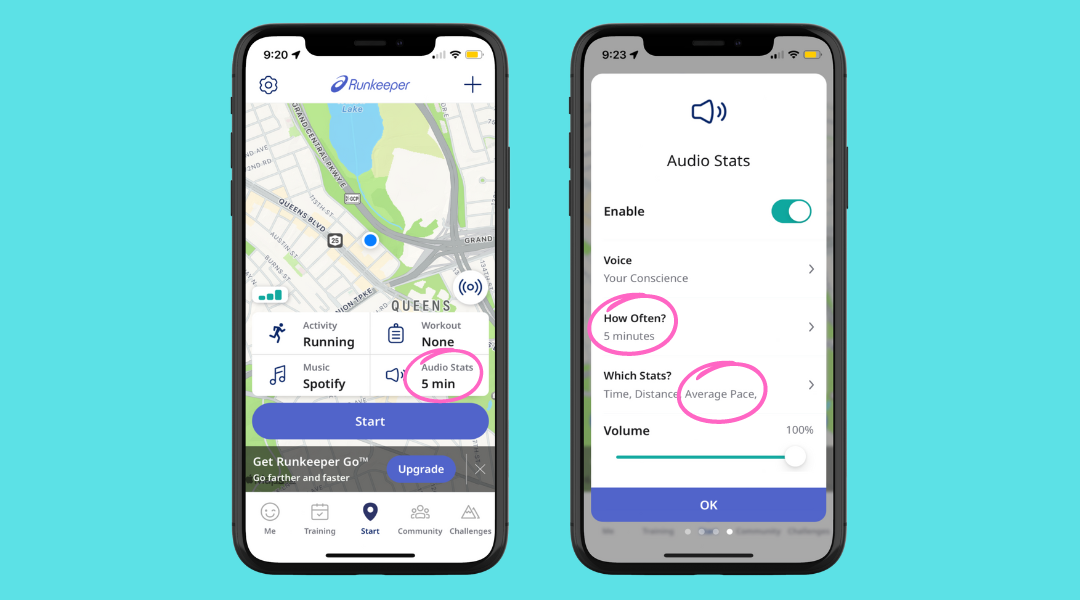From Couch Potato to Marathoner: A Midlife Running Journey
Discover how to transform from a non-runner to marathoner with three essential tips on pacing, form, and building a running habit at any age and stage in life!

“Do you like to run?” If you had asked me that in my teens or 20s, I might have scoffed and said, “Only if I'm chasing after a food truck.” Back then, I was the kid who always finished dead last, huffing and puffing my way through the one-mile “Fun” run at school. I was thrilled the year I could finally choose Band over Phys Ed. I got comfortable with the Freshman 15 and contented myself with couch potato status for life.
Fast forward to my 30s. I finally decided to put my stubbornness to good use and change the narrative. Now, a decade later, with four full marathons and twice as many half marathons under my belt, I can confidently say, “Yes, I guess I DO like to run.”

Not only do I run for myself, but I also love bringing others along for the ride. If a former couch potato like me can reach this point—and get right back to it after having kids—I'm certain anyone can do it with a plan and some persistence.
Recently, a couple of friends asked me for tips to get started. Their goals are to boost their endurance for health and eventually train for a long race. Although they exercise regularly and are relatively fit, running 1-2 miles without stopping is still a challenge. If this sounds like you, let's hit the ground running!
Tip #1: Slow Down to Go the Distance
The first mistake most people make when starting out is going too fast. You can't manage what you don't measure, so download a running tracker to your phone and have a way to carry it with you when you run. Once you're thoroughly addicted, you can invest in all the gadgets, from smartwatches to heart rate monitors. However, when you're just starting out, it's best to keep things simple. Have a pair of trainers? A smartphone? A pocket? You’re good to go!
My go-to for tracking runs has been Runkeeper for years. It's free to use with some optional upgrades. Open it up before your first tracked run and adjust the audio stats. Set it to announce every 3-5 minutes or 1/4-1/2 mile. Besides announcing time and distance, I also set mine to give me average pace and current split pace. My goal when starting out was to ensure my current split pace was never faster than 10-11 minutes per mile. When I first started, I constantly checked my phone and was startled to see myself sometimes pushing 7-8 minute paces. No wonder I felt like hurling after a couple of minutes!

If you're getting out of breath and have to slow down to walk between announcements, that's a good indicator to have your tracker announce more frequently and reduce your overall pace. After a few runs, you’ll have a baseline for what a comfortable, endurance-building pace is for you. This pace, often referred to as Zone 2, should allow you to continue for a long time and still comfortably talk without gasping for air.
Set a goal to run for a set amount of time or a set distance, but don't worry about your overall pace. 20-30 minutes or 2-3 miles will probably be more than enough of a challenge while you're working to build up endurance. Keep to this shorter distance until you can maintain that Zone 2 pace for the entire run without needing to stop or slow to a walk.
The Benefits of Zone 2 Training
Zone 2 training is essential for all levels of runners, but especially for those of us just getting started. Here are some compelling reasons to incorporate Zone 2 cardio into your routine:
- Fat-Burning Abilities: This is what most people think of first when it comes to cardio. Zone 2 cardio specifically improves mitochondrial function, which increases your ability to burn fat. This means you’re not only building endurance but also improving your body’s efficiency in using fat as a fuel source.
- Better Mental Health: Running in Zone 2 isn’t just good for your body—it’s great for your mind. Increased blood flow and oxygen can improve memory and brain function, as well as stimulate brain cell growing hormone production. This level of exercise has been shown to correlate with boosted self-esteem and social functioning, and decreased anxiety, depression, and insomnia.
- Faster Recovery: Zone 2 cardio improves blood flow, which speeds up muscle repair. This means you’ll bounce back quicker after each run, ready to tackle your next workout without feeling overly fatigued.
- Endurance and Longevity: According to Dr. Peter Attia, author of Outlive, "Exercise might be the most potent 'drug' we have for extending the quality and perhaps quantity of our years of life."
By making Zone 2 training a part of your regular routine, you’re setting yourself up for a healthier, more sustainable running journey. So, lace up those shoes, find your comfortable pace, and start reaping the many benefits.
Tip #2: Adopt a More Efficient Running Form
If you grew up in the 80s like me, you were probably taught to run from heel to toe. Striking with your heel, rolling through to your toes, and pushing off for your next heel strike. Now we know this is great for walking but terrible for running. Striking the ground with your heel functions like a brake, sending forces and momentum backward, and puts a lot of strain on your joints. Instead, shift to a midfoot strike (think, the ball of your foot) with your body in alignment instead of planting your foot way out in front of your hips. Just making this one change can noticeably reduce effort and eliminate shin splints. If you feel it in your calves, check to ensure you’re not over-correcting by landing on your toes.
The video below does a great job breaking down everything from head to toe for an efficient, injury-reducing running form, including stationary exercises to reinforce good habits when you’re not pounding the pavement. It's a lot to think about all the time, so instead, when you start to feel winded and want to stop, slow down and do a body scan to see if there’s anywhere your form could be improved. Are you still landing midfoot? Are your elbows staying close to your sides? Are your neck and face muscles relaxed? Are you taking full breaths into your diaphragm?
Tip #3: Turn It Into a Habit
What will keep you motivated to continue putting in the effort? For some, it’s just taking that first step to schedule set times and days every week. Put it on your calendar and honor that appointment with yourself. If you're just starting out, aim for no more than 2-3 times a week. Rest is important, and you don't want to burn out or injure yourself by doing too much too fast.
Find an accountability buddy. It could be someone who meets and runs with you, or a group chat where everyone shares their post-workout stats after each session. As long as it’s someone you can count on and who’s also counting on you! I met my now-husband when I was just starting out, and he has always been my biggest champion. He encouraged me to sign up for my first race (the 4-mile NYC Midnight New Year's Eve Run) and always says, “If you can run 4 miles, you can run a 10K. If you can run a 10K, you can run a Half. If you can run a Half, you can run a Full!”

Try some temptation bundling. Have an audiobook, podcast, or album you’ve been wanting to listen to? Pop in your earbuds and listen while you move. When the weather doesn’t cooperate, hit the treadmill with a show on Netflix you’ve been eager to binge.
Sign up for a race. For those who thrive on structure, there are countless training plans out there to help you take it to the next level. Having a big race looming on the horizon is usually the only thing that motivates me to run more than a few miles a week.
When I first began training for races, I loosely followed Hal Higdon's Novice training plans. What I appreciate about these plans is that they gradually build up your mileage while also allowing you to improve your overall pace during the shorter mid-week runs. The closer you stick to the plan, the stronger you'll be at the finish line.
How Long Will It Take to Become a Runner?
From the moment you slip on those trainers and complete your first mile, you're already a runner in my book! But if you're aiming for the sweet, external validation of a finisher's medal, here are some time frames to consider:
- For a 5K or 10K, most plans span about 8 weeks.
- For a Half Marathon, you'll need about 12 weeks.
- For a full Marathon, give yourself at least 18 weeks.
For instance, the NYC Marathon takes place the first weekend of November, so you should start training by the end of June or the first week of July. If you’re following a more gradual plan or one with fewer runs per week, like Hal Higdon's Marathon 3—which I began using after becoming a mom and could only commit to running three days a week—you'll need to start even earlier.
So there you have it—a journey from the couch to the finish line, with plenty of sweat and persistence along the way. Whether you're just lacing up your sneakers for the first time or looking to push your limits further, remember that every runner started with that first step. Keep the pace steady, focus on form, and turn those miles into a lifelong habit. Before you know it, you'll be crossing your own finish lines, grinning from ear to ear.




Comments ()